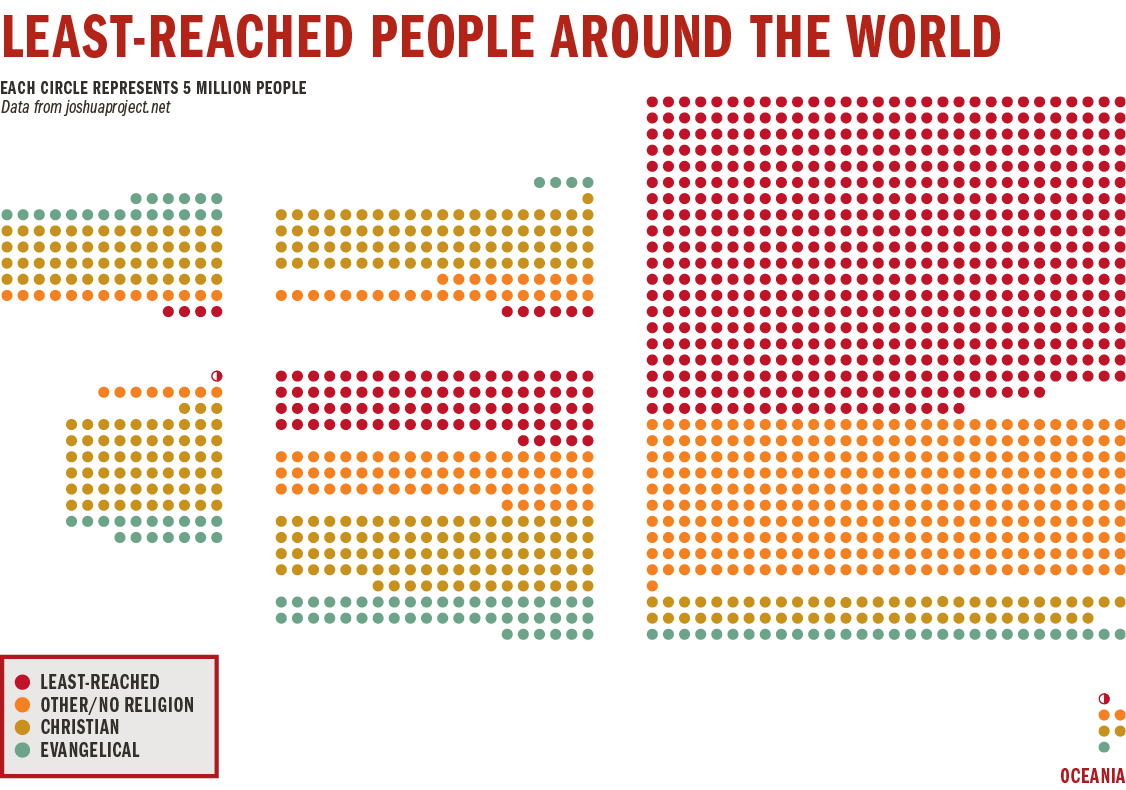Why we focus on the least-reached
- June
“Suppose one of you has a hundred sheep and loses one of them. Doesn’t he leave the ninety-nine in the open country and go after the lost sheep until he finds it? And when he finds it, he joyfully puts it on his shoulders and goes home. Then he calls his friends and neighbors together and says, ‘Rejoice with me; I have found my lost sheep.’ I tell you that in the same way there will be more rejoicing in heaven over one sinner who repents than over ninety-nine righteous persons who do not need to repent.” — Luke 15:4–7
Jesus doesn’t use numbers in his teaching very often. It is really stunning how Jesus uses these numerical comparisons to make an important point. In fact, when we look at this passage in context with the rest of the chapter, we see Jesus uses three parables to emphasize how critical just one thing is:
1 out of 100 sheep
1 out of 10 coins
1 out of 2 sons
Finding the lost sheep, coins, or children is so critical to God that he will go out of his way to find them. We are invited into this mission to join God in his work of reconciling all of creation to himself. This is why sharing the good news of Jesus with the least-reached people of the world is so critical to EMM’s work.
So what do we mean when we say, “least-reached?” Let’s start with what it is not. Sometimes, you will hear people use the term “unreached,” which is not a bad word, but implies that we’re trying to find “uncontacted peoples” around the world. There are only about 10,000 people in the entire world who would be identified as “uncontacted” — that is, hunter-gatherers who avoid or do not have interaction with the rest of the world. (Ironically, the continent with the lowest number of least-reached people is actually the place with the most uncontacted tribes: South America.)
When we say least-reached people, we are referring to a people group among which there is no indigenous community of believing Christians with adequate numbers and resources to evangelize this people group without outside assistance. This often means that a people group has fewer than 5% Christian adherents and is less than 2% evangelical. (Definition adapted from the Joshua Project.)
EMM has done mission work around the world for more than 100 years. First, we began with local missions in the U.S., and went on to carry out international missions in more than 100 countries, leading to the formation of more than 20 church multiplication movements. Our first international work among the Luo people in Tanganyika was working with a least-reached people group at the time. Throughout the decades, that has continued to be our focus.
Now, we’re asking the question, “Will God do this again?” Brothers and sisters, quite simply, he is doing this again! And EMM wants to continue being part of what God is doing around the world, in searching to find those who are far from him.
I am beyond thankful for every person who has sustained the work of EMM for over 100 years. You have also been driven by this vision to see all people come to know Jesus. Your generosity has continued to bless everyone who is hearing the gospel for the first time. We encourage you to make a gift to EMM’s Impact Fund by June 31. You can give online at EMM.ORG/GIVE or by returning the envelope to us with your gift.
Thank you for your continued generosity!

Oftentimes, pictures speak louder than words, so I want to draw your attention to the graphic above, highlighting a few important points regarding why EMM focuses on least-reached people:
Asia is home to most least-reached people. More than 60 percent of the world’s population lives in Asia. In fact, 5 of the 10 largest countries by population are all in Asia. This is one of the reasons that EMM has created two focus regions on this continent: Central Asia and Southeast Asia. We’re eager to do this work together with Asian Christians who are passionate about reaching the least-reached people in this region.
Africa is home to both many least-reached people and a lot of Christians. It would be an understatement to say that Africa is a huge continent, in terms of both geography and population. While nearly half of Africa identifies as Christian, it also has nearly 1,000 least-reached people groups. Being able to partner with African Christians in mission is critical for our work in places like West Africa.
The Western Hemisphere is very reached. South America and Oceania (including Australia) have significant access to the gospel. There are fewer than 1 million and 2 million least-reached people in each region, respectively. North America is not least-reached, but there are people here who are. We can look to these regions to partner together in sending workers to unreached parts of the world.
Migration changes everything. Least-reached people in North America and Europe are generally immigrants who came from communities around the world that are least-reached. This is one of the reasons why we focus on Central Europe and Lancaster, Pa.
“Christian” does not imply that people have an active relationship with Jesus. Many people around the world who identify with Christianity are nominal. This is why we’re focused on mission in Central Europe which has a strong history of secularism.It’s also worth noting, that just because someone is “evangelical,” doesn’t mean that they have an active relationship with Jesus either. However, we generally find that people tend to have more active relationships with Jesus when they identify as “evangelical.”

Dr. Marvin Lorenzana serves as president of EMM.
Messenger is a monthly newsletter and prayer guide
Sign up to receive the email or print versions below
